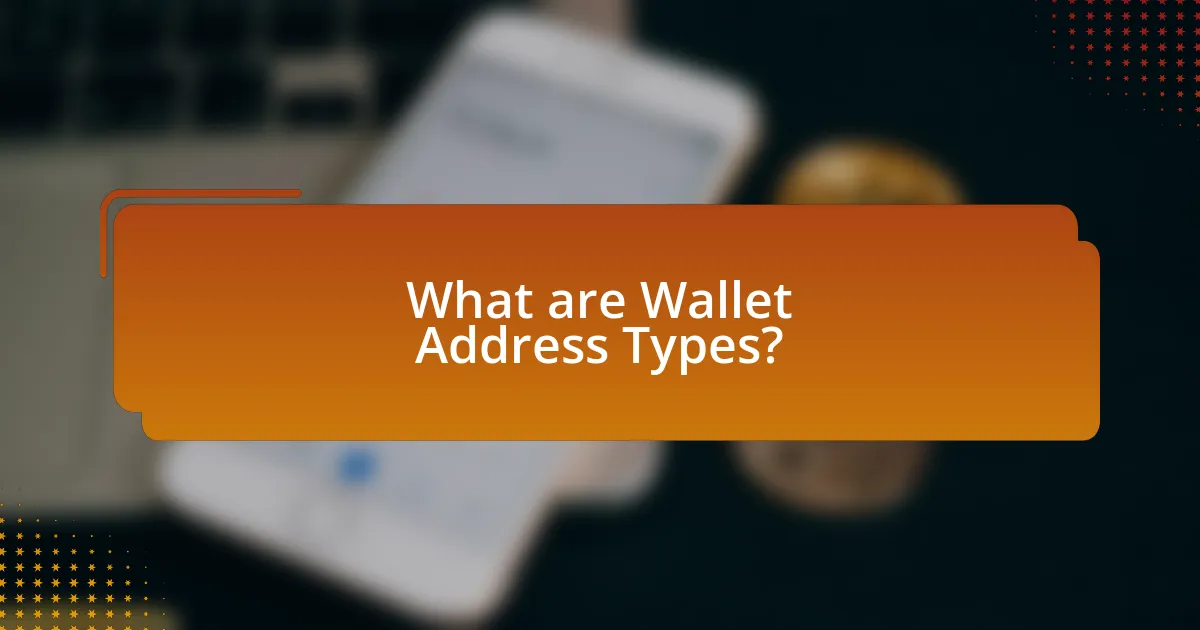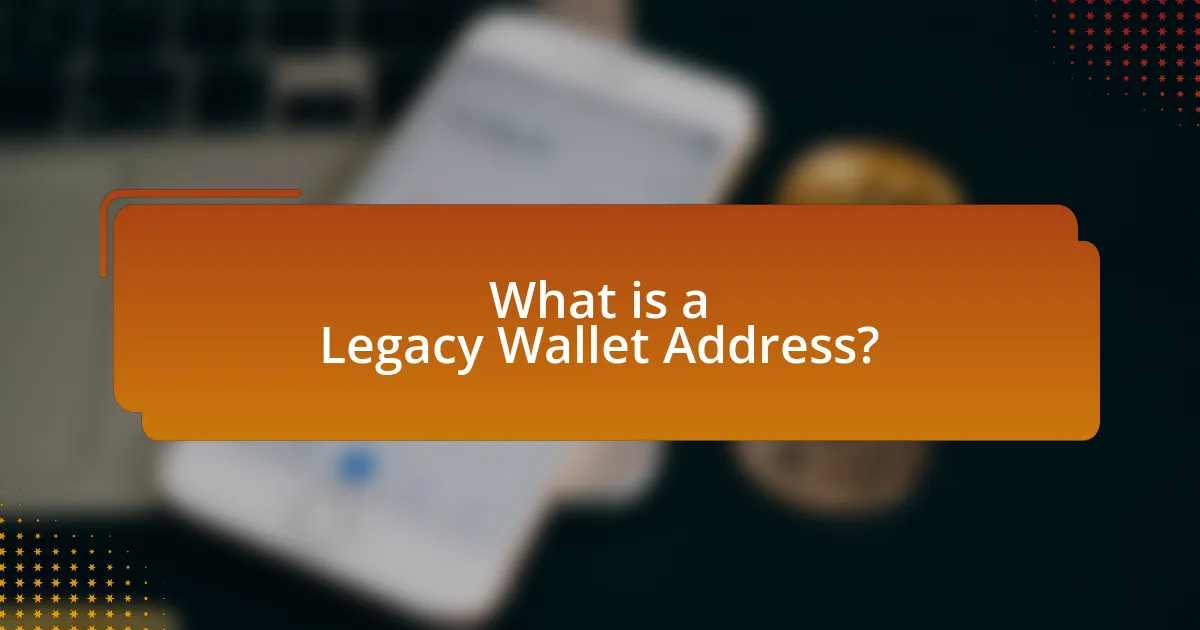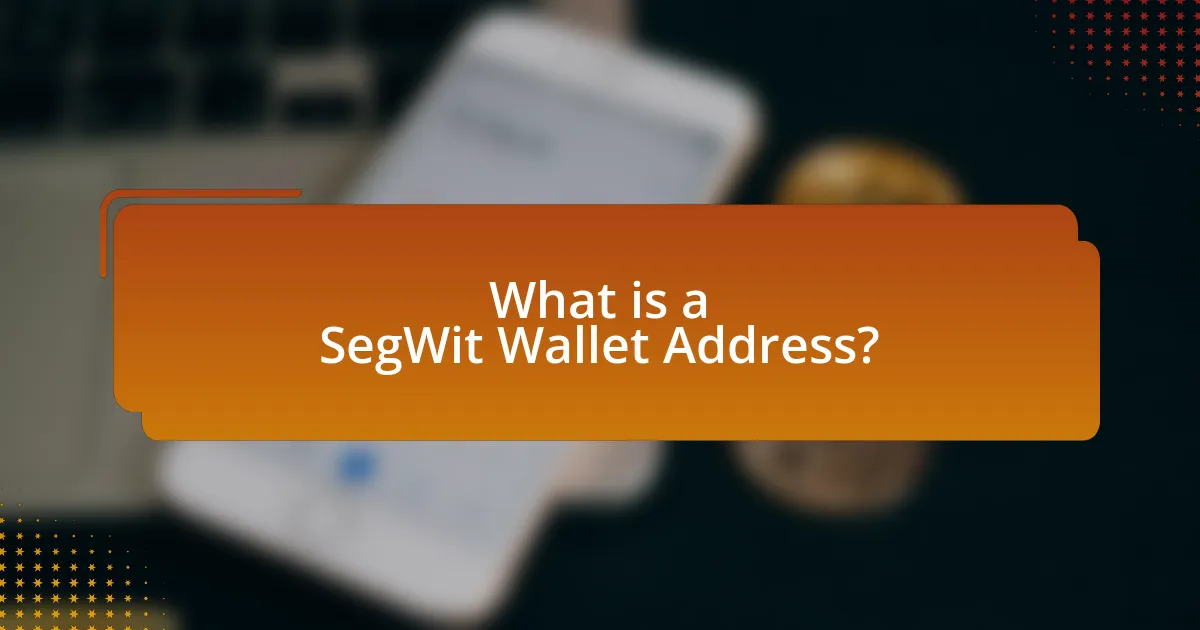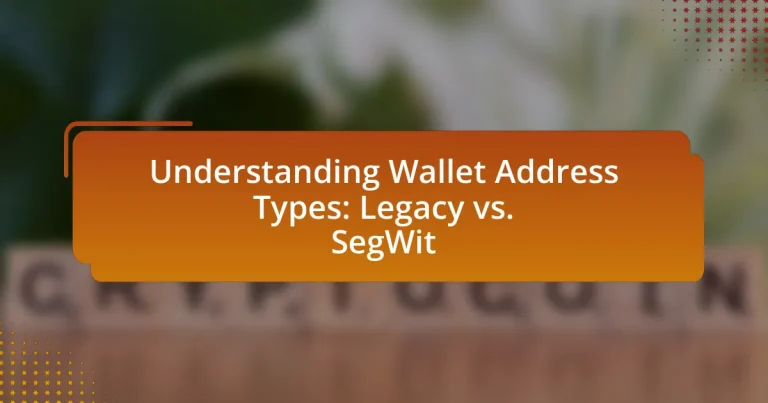Wallet address types are essential formats used to represent cryptocurrency addresses, particularly in Bitcoin transactions, with the primary categories being Legacy and SegWit addresses. Legacy addresses, starting with ‘1’, are the original format and are compatible with all wallets, but they often incur higher transaction fees and slower processing times. In contrast, SegWit addresses, which can start with ‘3’ or ‘bc1’, utilize Segregated Witness technology to enhance transaction efficiency, reduce fees, and improve scalability. Understanding these differences is crucial for optimizing cryptocurrency transactions, ensuring compatibility with various wallets and exchanges, and making informed decisions regarding transaction costs and speeds.

What are Wallet Address Types?
Wallet address types refer to the different formats used to represent cryptocurrency addresses, primarily in Bitcoin transactions. The main types include Legacy addresses, which start with a ‘1’, and SegWit addresses, which can start with ‘3’ for Pay-to-Script-Hash (P2SH) or ‘bc1’ for native SegWit (Bech32). Legacy addresses are the original format, while SegWit addresses offer benefits such as lower transaction fees and increased block capacity due to their ability to separate signature data from transaction data. These distinctions are crucial for users to understand in order to optimize their cryptocurrency transactions and ensure compatibility with various wallets and exchanges.
How do Wallet Address Types differ from one another?
Wallet address types differ primarily in their structure and functionality, specifically between Legacy and SegWit addresses. Legacy addresses, starting with a ‘1’, are the original Bitcoin address format, while SegWit addresses, which can start with ‘3’ or ‘bc1’, utilize a more efficient transaction format that reduces fees and increases block capacity. SegWit addresses also enable features like transaction malleability fixes and improved scalability, making them more advantageous for users and developers. The differences in address types directly impact transaction efficiency and cost, with SegWit offering significant improvements over Legacy addresses.
What are the key characteristics of Legacy addresses?
Legacy addresses are the original Bitcoin address format, characterized by their use of the Base58Check encoding and starting with the digit ‘1’. These addresses are compatible with all Bitcoin wallets and transactions, making them widely accepted. Additionally, Legacy addresses do not support advanced features such as Segregated Witness (SegWit), which can lead to higher transaction fees and slower processing times during network congestion. The simplicity of Legacy addresses contributes to their enduring use, despite the introduction of more efficient address types.
What are the key characteristics of SegWit addresses?
SegWit addresses are characterized by their ability to separate transaction signatures from transaction data, which enhances scalability and reduces fees. This separation allows for more transactions to be included in a single block, effectively increasing the block size limit from 1 MB to approximately 4 MB in terms of transaction capacity. Additionally, SegWit addresses use a new format known as Bech32, which starts with “bc1” and improves error detection and user experience. These features collectively contribute to faster transaction processing and lower costs, making SegWit addresses a significant advancement in Bitcoin technology.
Why is it important to understand Wallet Address Types?
Understanding wallet address types is crucial because it directly impacts transaction efficiency, security, and compatibility within the cryptocurrency ecosystem. Different address types, such as Legacy and SegWit, have distinct characteristics that affect transaction fees and speed; for instance, SegWit addresses allow for smaller transaction sizes, leading to lower fees and faster confirmations. Additionally, using the correct address type ensures compatibility with various wallets and exchanges, preventing potential loss of funds. Therefore, knowledge of wallet address types enhances user experience and optimizes the use of cryptocurrency.
How do Wallet Address Types impact transaction fees?
Wallet address types significantly impact transaction fees due to their differing structures and efficiencies. Legacy addresses, which are the original Bitcoin address format, often result in higher fees because they require more data to process transactions. In contrast, SegWit (Segregated Witness) addresses optimize transaction data by separating signature information, allowing for more transactions to be included in a block. This efficiency leads to lower fees, as SegWit transactions can take up less space on the blockchain, making them cheaper to process. According to data from the Bitcoin network, SegWit adoption has reduced average transaction fees by approximately 30% compared to legacy transactions, demonstrating the financial benefits of using more efficient wallet address types.
What role do Wallet Address Types play in transaction speed?
Wallet address types significantly influence transaction speed by determining how data is structured and processed on the blockchain. Specifically, SegWit (Segregated Witness) addresses allow for more efficient data storage by separating transaction signatures from transaction data, which increases the block capacity and reduces congestion. This results in faster transaction confirmations compared to Legacy addresses, which do not utilize this optimization. According to Bitcoin’s protocol, SegWit transactions can lead to a reduction in fees and quicker processing times, as evidenced by the increased adoption of SegWit, which has been shown to improve overall network efficiency.

What is a Legacy Wallet Address?
A Legacy Wallet Address is a type of Bitcoin address that begins with the number ‘1’ and is based on the original Bitcoin protocol. These addresses are compatible with all Bitcoin wallets and are often referred to as Pay-to-Public-Key-Hash (P2PKH) addresses. Legacy Wallet Addresses were the first format introduced in Bitcoin’s early days, and they remain widely used today, despite the introduction of newer address types like SegWit. The continued use of Legacy Wallet Addresses is supported by their universal compatibility across various wallets and exchanges, ensuring that users can send and receive Bitcoin without issues.
How does a Legacy Wallet Address function?
A Legacy Wallet Address functions by utilizing the original Bitcoin address format, known as Pay-to-Public-Key-Hash (P2PKH), which begins with the number ‘1’. This format allows users to send and receive Bitcoin transactions by providing a unique alphanumeric string that corresponds to their wallet. Legacy addresses are compatible with all Bitcoin wallets and services, ensuring broad accessibility. The underlying technology relies on public-key cryptography, where the wallet generates a public key from a private key, and the address is derived from this public key through a hashing process. This method has been foundational since Bitcoin’s inception, ensuring secure and verifiable transactions on the blockchain.
What are the advantages of using Legacy Wallet Addresses?
Legacy wallet addresses offer several advantages, primarily their widespread compatibility and simplicity. These addresses, which begin with a ‘1’, are universally accepted across all Bitcoin wallets and exchanges, ensuring seamless transactions without the need for additional configurations. Furthermore, legacy addresses are straightforward for users to understand and utilize, making them accessible for newcomers to cryptocurrency. Their established presence in the market means that users can easily find support and resources for troubleshooting or guidance. Additionally, legacy addresses do not rely on newer technologies, which may not be supported by all platforms, thus providing a reliable option for users who prioritize stability and compatibility in their transactions.
What are the disadvantages of using Legacy Wallet Addresses?
Legacy wallet addresses have several disadvantages, primarily related to transaction fees and efficiency. These addresses, which are based on the original Bitcoin protocol, often incur higher transaction fees due to their larger size and the way they interact with the blockchain. For instance, transactions from legacy addresses typically require more data to be processed, leading to increased costs during times of network congestion. Additionally, legacy addresses do not support features like Segregated Witness (SegWit), which enhances transaction speed and reduces fees by separating signature data from transaction data. This lack of support means users miss out on the benefits of improved scalability and faster confirmation times that SegWit offers.
What are the common use cases for Legacy Wallet Addresses?
Legacy wallet addresses are primarily used for receiving and storing Bitcoin transactions. These addresses, which begin with the number ‘1’, are compatible with all Bitcoin wallets and exchanges, making them widely accepted for transactions. Additionally, legacy addresses are often utilized in scenarios where users prioritize simplicity and compatibility over advanced features, such as those offered by SegWit addresses. The historical significance of legacy addresses is underscored by their role in the early adoption of Bitcoin, as they were the first type of address introduced in the network.
How do Legacy Wallet Addresses integrate with existing systems?
Legacy wallet addresses integrate with existing systems by utilizing the original Bitcoin address format, which is recognized by all Bitcoin wallets and exchanges. This compatibility ensures that transactions can be processed seamlessly across various platforms, as legacy addresses start with the number ‘1’ and are supported universally since the inception of Bitcoin. The widespread acceptance of legacy addresses facilitates user access to a broad range of services, including trading, storage, and payment processing, without requiring additional adaptations or updates to the existing infrastructure.
What challenges do users face with Legacy Wallet Addresses?
Users face several challenges with Legacy Wallet Addresses, primarily related to transaction fees and compatibility. Legacy Wallet Addresses often incur higher transaction fees due to their larger size and the way they interact with the Bitcoin network, which can lead to slower transaction confirmations. Additionally, these addresses are not compatible with newer technologies like SegWit, limiting users’ ability to take advantage of lower fees and faster transactions. This incompatibility can also create issues when users attempt to send or receive funds between different wallet types, leading to potential loss of funds or transaction failures.

What is a SegWit Wallet Address?
A SegWit wallet address is a type of Bitcoin address that utilizes Segregated Witness (SegWit) technology to improve transaction efficiency and reduce fees. SegWit separates transaction signatures from the transaction data, allowing for more transactions to be included in each block. This technology was implemented in Bitcoin in 2017 and has been shown to increase the block size limit effectively, enabling faster transaction processing and lower costs for users.
How does a SegWit Wallet Address function?
A SegWit wallet address functions by separating the transaction signature data from the transaction data, allowing for more efficient use of block space. This separation enables a higher number of transactions to be included in each block, effectively increasing the network’s capacity and reducing transaction fees. SegWit, or Segregated Witness, was implemented in Bitcoin through a soft fork in 2017, which allowed for backward compatibility with legacy addresses. The technical structure of a SegWit address includes a version byte that indicates it is a SegWit address, followed by the public key hash, which is encoded in a format called Bech32. This format enhances error detection and improves usability.
What are the advantages of using SegWit Wallet Addresses?
SegWit wallet addresses offer several advantages, primarily improved transaction efficiency and reduced fees. By separating transaction signatures from the transaction data, SegWit allows more transactions to fit into a single block, effectively increasing the block size limit. This leads to lower transaction fees, as users can benefit from reduced congestion on the Bitcoin network. Additionally, SegWit enhances the security of transactions by mitigating risks associated with transaction malleability, which allows for better implementation of second-layer solutions like the Lightning Network. These benefits are supported by data showing that SegWit adoption has led to a significant increase in transaction throughput and a decrease in average fees on the Bitcoin network.
What are the disadvantages of using SegWit Wallet Addresses?
The disadvantages of using SegWit wallet addresses include potential compatibility issues with non-SegWit wallets and services, which may not recognize or support these addresses. This can lead to transaction failures or delays when sending or receiving funds. Additionally, while SegWit improves transaction efficiency and reduces fees, some users may find the transition from legacy addresses confusing, leading to mistakes in address entry. Furthermore, SegWit addresses are not universally adopted, meaning that users may encounter limitations when interacting with certain exchanges or platforms that do not support SegWit transactions.
What are the common use cases for SegWit Wallet Addresses?
SegWit wallet addresses are commonly used for reducing transaction fees, increasing transaction speed, and enhancing scalability on the Bitcoin network. By separating transaction signatures from the transaction data, SegWit allows more transactions to fit into a single block, which leads to lower fees and faster confirmations. Additionally, SegWit addresses support features like the Lightning Network, enabling instant and low-cost transactions. These use cases are validated by the significant adoption of SegWit, which has led to a notable increase in Bitcoin transaction efficiency since its implementation in 2017.
How do SegWit Wallet Addresses improve transaction efficiency?
SegWit wallet addresses improve transaction efficiency by reducing the size of transactions, which allows more transactions to fit into a single block. This is achieved through a method called Segregated Witness, which separates the signature data from the transaction data. As a result, the effective block size increases, enabling higher throughput and lower fees per transaction. According to data from the Bitcoin network, SegWit adoption has led to a significant increase in transaction capacity, with blocks accommodating more transactions compared to legacy addresses.
What challenges do users face with SegWit Wallet Addresses?
Users face several challenges with SegWit wallet addresses, primarily related to compatibility and usability. One significant issue is that not all exchanges and wallets support SegWit addresses, which can lead to difficulties in sending and receiving funds. For instance, some platforms may only accept legacy addresses, causing confusion and potential loss of funds if users mistakenly send to an incompatible address. Additionally, users may struggle with understanding the difference between SegWit and legacy addresses, leading to errors in transactions. Furthermore, while SegWit improves transaction speed and reduces fees, users may not fully grasp these benefits, resulting in missed opportunities for cost savings.
How do Legacy and SegWit Wallet Addresses compare?
Legacy wallet addresses, which start with a ‘1’, are the original Bitcoin address format, while SegWit wallet addresses, starting with a ‘3’ or ‘bc1’, utilize the Segregated Witness protocol to enhance transaction efficiency. SegWit addresses allow for smaller transaction sizes, leading to lower fees and increased block capacity, as they separate signature data from transaction data. This separation enables more transactions to fit within a single block, improving scalability. Additionally, SegWit addresses support features like transaction malleability fixes, which Legacy addresses do not offer. The adoption of SegWit has been significant, with over 50% of Bitcoin transactions utilizing this format as of late 2023, demonstrating its advantages over Legacy addresses.
What are the key differences in transaction fees between Legacy and SegWit?
Legacy transaction fees are generally higher than SegWit transaction fees due to the way data is stored and processed. Legacy transactions require more block space because they do not utilize the Segregated Witness technology, which separates signature data from transaction data, allowing more transactions to fit into a single block. As a result, SegWit transactions can be processed more efficiently, leading to lower fees. For example, SegWit transactions can reduce the size of transactions by approximately 30-40%, which directly translates to lower fees per transaction. This efficiency is supported by data from the Bitcoin network, which shows that SegWit adoption has led to a significant decrease in average transaction fees over time.
How do Legacy and SegWit Wallet Addresses affect user experience?
Legacy and SegWit wallet addresses significantly affect user experience by influencing transaction speed, fees, and compatibility. Legacy addresses, which start with a ‘1’, are widely supported but often incur higher transaction fees and slower confirmation times due to larger data sizes. In contrast, SegWit addresses, beginning with ‘3’ or ‘bc1’, reduce transaction size by separating signature data, leading to lower fees and faster processing. According to a study by the Bitcoin Association, SegWit adoption has resulted in a 40% reduction in transaction fees on average, enhancing user satisfaction. Thus, the choice between Legacy and SegWit addresses directly impacts the efficiency and cost-effectiveness of transactions for users.
What should users consider when choosing between Legacy and SegWit?
Users should consider transaction fees, speed, and compatibility when choosing between Legacy and SegWit addresses. Legacy addresses typically incur higher transaction fees due to larger data sizes, while SegWit addresses reduce fees by optimizing block space, allowing for more transactions per block. Additionally, SegWit transactions are processed faster because they are smaller in size, leading to quicker confirmations. Compatibility is also crucial; Legacy addresses are universally accepted, but some wallets and exchanges may not support SegWit, which could limit usability. Therefore, evaluating these factors helps users make informed decisions based on their specific needs and circumstances.
How can users determine which Wallet Address Type is best for their needs?
Users can determine which Wallet Address Type is best for their needs by evaluating their transaction frequency, fee sensitivity, and compatibility with various platforms. For instance, SegWit addresses offer lower transaction fees and faster processing times due to their ability to separate signature data from transaction data, making them ideal for users who prioritize cost efficiency and speed. Conversely, Legacy addresses may be more suitable for users who require compatibility with older wallets or services that do not support SegWit. Additionally, users should consider their long-term plans for cryptocurrency use, as SegWit is increasingly becoming the standard, which may influence future transactions and integrations.
What best practices should users follow when using Wallet Address Types?
Users should follow several best practices when using wallet address types, including ensuring compatibility with the intended recipient’s wallet, using SegWit addresses for lower transaction fees and faster processing times, and regularly backing up wallet information. Compatibility is crucial because not all wallets support both Legacy and SegWit addresses; for instance, sending a SegWit address to a Legacy wallet can result in lost funds. Utilizing SegWit addresses can reduce transaction fees by approximately 30% due to their smaller size, as confirmed by various blockchain analyses. Regular backups of wallet information, including private keys and recovery phrases, are essential to prevent loss of access to funds, as losing these can result in permanent loss of cryptocurrency.


